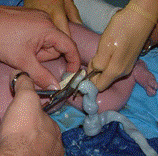
In 1801, Erasmus Darwin (Charles Darwin's grandfather) gave us some wise insight on this subject:
"Another thing very injurious to the child, is the tying and cutting of the
navel string too soon; which should always be left till the child has not only
repeatedly breathed but till all pulsation in the cord ceases.
As
otherwise the child is much weaker than it ought to be, a portion of the blood
being left in the placenta, which ought to have been in the child."

Cutting the Cord - When a baby is born, one of the first procedures performed is
the clamping and cutting of the umbilical cord. A newborn's lungs are in a
"compacted state" whilst still in the womb, however,
when the infant is born, the placenta
and cord pulse for up to 20 minutes, delivering a burst of blood volume to the
infant's system, necessary for the lungs to expand.
Unfortunately, many hospitals and doctors are clamping the umbilical cord too
soon, often within one minute of birth. Since they believe it will reduce the mother's
risk of excess bleeding and the baby's risk of jaundice. Often cords are also
clamped early to collect cord blood and cord stem cells to be used for medical
and commercial purposes.
Research is revealing that clamping the umbilical cord before two or three full
minutes have elapsed, robs your baby of much-needed blood and oxygen.
Without the burst of blood from the placenta, the infant's blood pressure drops
as its lungs fail to open as they should, creating a chain reaction of
effects that can include brain and lung
damage. One of the primary arguments
for delaying cord clamping has to do with the way a baby breathes just before
and after being born.
Dr. Mercola explains a baby's First Breaths in
Detail. From his
article "Are Doctors Causing Infant Brain
Damage by Clamping the Umbilical Cord Prematurely?
"Before birth, the baby's lungs are
filled with fluid and very little blood flows through them; the child receives
oxygen from its mother through the placenta and cord. This placental oxygen
supply continues after the child is born until the lungs are working and
supplying oxygen -- that is, when they are filled with air and all the blood
from the right side of the heart is flowing through them.
After birth, when the child is crying and pink, the cord vessels clamp
themselves. During this interval between birth and natural clamping, blood is
transfused from the placenta to establish blood flow through the baby's lungs.
The natural process protects the baby's brain by providing a continuous oxygen
supply from two sources until the second source is functioning well.
However, according to George M. Morley, M.B., Ch. B., FACOG of
www.cordclamping.com, immediate cord
clamping at birth instantly cuts off the placental oxygen supply and the baby
remains asphyxiated until the lungs function. Blood, which normally would have
been transfused to establish the child's lung circulation, remains clamped in
the placenta, and the child diverts blood from all other organs to fill the lung
blood vessels.
While most full-term babies have enough blood to establish lung function and
prevent brain damage, the process often leaves them pale and weak. For premature
babies, the process can be even more devastating. And no matter what, immediate
cord clamping will cause some degree of asphyxia and loss of blood volume,
because it:
(1) Completely cuts off the infant brain's oxygen supply from the placenta before lungs begin to function
(2) Stops placental transfusion. The transfer of a large volume of blood (up to 50% increase in total blood volume) that is used mainly to establish circulation through the baby's lungs to start them functioning."
Possible Problems resulting from Premature Cord Clamping. Premature clamping of the umbilical cord increases the baby's risk of brain hemorrhage and breathing problems. It has been implicated as a contributing factor in:
• Hypotension / Hypovolemia (Low blood pressure /volume)
• Autism
• Cerebral Palsy
• Anemia -with resultant cognitive deficits
• Learning disorders and mental deficiency
• Behavioral disorders
• Respiratory distress
• Death (as a result of brain injuries)